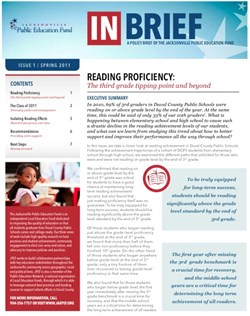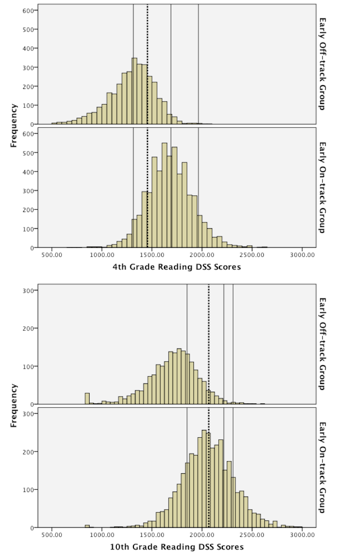inBRIEF Spring 2011: Reading proficiency
6/6/2011
 Reading Proficiency
Reading Proficiency
The third grade tipping point and beyond
What is happening between elementary school and high school to cause such a drastic decline in the reading achievement levels of our students? What can we learn from studying this trend about how to better support and improve students' performance all the way through school?
In 2010, more than two-thirds of 3rd grade students were reading on or above grade level. But the same is true of only a third of 10th graders. In this issue, we take a closer look at reading achievement in Duval County Public Schools. Following the achievement trajectories of a cohort of DCPS students from elementary school through high school, we examined the different paths that unfolded for those who were and were not on grade level by the end of 3rd grade.
Learn more
Links to Additional Resources
About the DCPS reading initiative: Read It Forward Jax
About school, district and state level FCAT achievement on Florida DOE
DCPS Instructional Research & Accountability
Information about understanding the FCAT:
Florida DOE "About the Assessments"
Florida DOE FCAT FAQs
More information about supporting reading in the community:
Jacksonville Public Library kids events
Jacksonville Public Library Teen events
Jacksonville Public Library Resources for Parents & Teachers
Jacksonville Children's Commission
Reading is Fundamental Resources
Early Learning Coalition of Duval
Online extra: What about the test?
As we think about changes in student achievement outcomes from year to year, most of that change is due to the students moving on the test, but some of it is due to the test moving around the students.
 The FCAT is the standard assessment Florida uses for measuring student achievement from year to year, but that does not mean that all FCATs are created equal. FCAT administrations at different grade levels can vary in degrees of item difficulty, "cognitive complexity" (a measure of the relative demands of a question in terms of finding the answer, for example reading to find stated information versus reading to infer missing information), and with respect to where the cutoff scores for each achievement level are set.
The FCAT is the standard assessment Florida uses for measuring student achievement from year to year, but that does not mean that all FCATs are created equal. FCAT administrations at different grade levels can vary in degrees of item difficulty, "cognitive complexity" (a measure of the relative demands of a question in terms of finding the answer, for example reading to find stated information versus reading to infer missing information), and with respect to where the cutoff scores for each achievement level are set.
Each test contains a range of low, medium, and high complexity questions included in the FCAT Reading sections at each grade level. The 10th grade test contains a much higher percentage of questions asking students to think abstractly or solve complex problems than the 3rd grade test.
If we look at the distribution graphs (right) of students' DSS scores at 4th and 10th grades, we can see how the cutoff scores for each achievement level (represented by the vertical lines in each graph) also move somewhat unevenly between different grade levels. Clearly there is much more breathing room between cutoff scores to be a level 3 or 4 reader in 4th grade than there is in 10th grade.
While understanding these issues about the nature of the test is important for considering how to interpret student achievement changes from year to year, from a practical standpoint it does not change the fact that these are the requirements students must be able to meet. The FCAT is not a perfect test, and at some point it may be worth putting considerably more thought into how much emphasis we are placing on it as our primary source of information for judging students and teachers alike, but for now it remains the standard by which we've agreed to measure student learning from year to year. As such, the practical importance of knowing that it may be disproportionately more challenging to score on or above grade level in 10th grade than in earlier tests is that it underscores the importance of providing increased support for all students along the way to help them be ready to meet that demand.